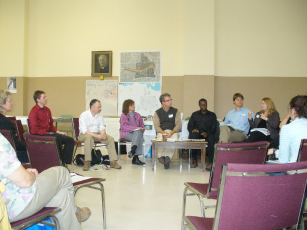The Centre for Urban Research and Education’s role in the Neighbourhood Planning Initiative might best be described as a “knowledge broker”. Our role has been to navigate between city protocols and community practices to generate new opportunities for dialogue, helping stakeholders to connect and reflect on their involvement. We have worn many hats:
- as an monitor during important phases of the pilot;
- a facilitator of, and participant in, the engagement process;
- and as an interlocutor to share the study findings with other policymakers and practitioners (e.g. other levels of government, academics, other community groups).
In practice, CURE has attempted to gather local and planning knowledge about, of and for the Neighbourhood Planning Initiative:
Knowledge about the community and city to understand the neighbourhood (Hintonburg) and the City of Ottawa.
- CURE engaged graduate students to track current and historical trends in the community through literature and archival reviews (See paper written by Malcolm Bird).
- We have participated in events like “walking tours” of the neighbourhood and community festivals like ArtsPark, led by the Hintonburg Community Association.
- In May 2006, CURE facilitated a workshop to help identify 11 target stakeholder groups which might be affected by the Neighbourhood Planning Initiative.
- We conducted two baseline surveys in the fall 2006 (over 350 responses). One survey was disseminated to city staff and the other targeted community stakeholders.
Knowledge of the community and city to get “on the street and in the office” feedback.
- The CURE team has observed over 50 community meetings, open houses and other community events on topics ranging from transit routes and city lamps, to public art and community safety.
- In partnership with Imagine Ottawa, CURE held a workshop with panellists ranging from City planning departments, local businesses, community organizations and local residents. The workshop was part of the City Social Forum and involved approximately 40 other Ottawa residents.

Learning Circle: Neighbourhood Planning Initiative, Imagine Ottawa City Social Forum, October 20, 2007
- We conducted dozens of interviews with a wide variety of stakeholders (e.g. city officials, local businesses, City Councillor, residents, community and voluntary organizations, etc.) to gather more personal, in-depth feedback.
- The CURE team conducted city staff and community stakeholder monitoring surveys.
- In April 2008, we facilitated a “Looking Back, Looking Ahead” workshop with the Continuity Task Force, the main community steering committee for the NPI, to identify lessons learned and advice for other neighbourhoods starting similar processes.
Knowledge for changing communities and cities to understand theoretical models and trends.
- CURE has undertaken reviews of literature on issues related to community engagement, community council models, evaluation methods, as well as reviews on related initiatives such as Action for Neighbourhood Change and Vibrant Communities.
- We have presented at, participated in and created opportunities for understanding the successes and challenges of community-engagement processes. These events have involved workshops and other forums involving government decision-makers, academics, students, foundations, community practitioners, the media and other citizens.
Opportunities have included:
- Conferences: Research into Action, Infrastructure Canada (Gatineau, Quebec, 2006); Canadian Political Science Association (Saskatoon, Saskatchewan, 2007); International Research Society for Public Management (Potsdam, Germany, 2007); Community-University Exposition, University of Victoria (Victoria, British Columbia, 2008); Association of Non-profit and Social Economy Research (Vancouver, British Columbia, 2008)
- Workshops: Imagine Ottawa, City Social Forum, 2007; Lunch n’ Learn, School of Public Policy and Administration, 2008; Reflecting and Reaching Resilience, Workshop with voluntary organizations, Collaborative Community Initiatives, Speakers Series, Federal Government (ongoing)
- Forums: “Think Ottawa: Your City, Your Say.” Hosted by CBC and Carleton University, October 12, 2006.
- CURE, in partnership with Hintonburg Community Association and the City of Ottawa, is creating a video research and storytelling project with a local filmmaker and journalism student. The stories, available on a Hintonburg YouTube Channel, will be used to inform policy and planning processes and will be integrated into university course teaching.